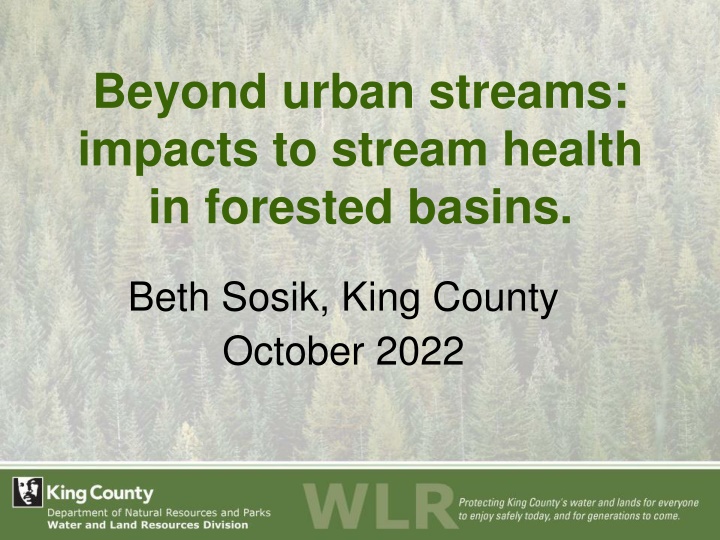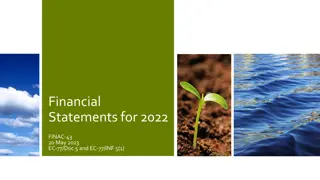
Study on Impacts of Urbanization on Stream Health in Forested Basins
This study explores the impacts of urbanization on stream health in forested basins, focusing on biotic integrity and fine sediment modeling. Using a Structural Equation Model (SEM), the research examines the influence of forest conditions and riparian areas on stream health. The findings suggest that riparian forest conditions have varying effects on the Benthic Index of Biotic Integrity (B-IBI) scores, with fine sediment proving to be a significant factor affecting stream health.
Download Presentation

Please find below an Image/Link to download the presentation.
The content on the website is provided AS IS for your information and personal use only. It may not be sold, licensed, or shared on other websites without obtaining consent from the author. If you encounter any issues during the download, it is possible that the publisher has removed the file from their server.
You are allowed to download the files provided on this website for personal or commercial use, subject to the condition that they are used lawfully. All files are the property of their respective owners.
The content on the website is provided AS IS for your information and personal use only. It may not be sold, licensed, or shared on other websites without obtaining consent from the author.
E N D
Presentation Transcript
Beyond urban streams: impacts to stream health in forested basins. Beth Sosik, King County October 2022
Study Objectives Puget Sound Partnership s Freshwater Strategic Initiative Draft Working Lands Strategy Biotic Integrity Benthic Index of Biotic Integrity (B-IBI) Study Questions: Do forest conditions influence biotic integrity? What mechanisms and spatial scales?
Rationale Undeveloped basins have best potential B-IBI scores But lots of underperforming scores! 303(d) Impairment listing at 65 in Puget Lowlands Impairment criterion Forest Harvest?
Approach Structural Equation Model (SEM) Holistic look at streams as a system Forests, streams, and physical conditions. 132 forested basins with minimal urban development Retrospective analysis Leverage existing B-IBI data and spatial datasets Relied heavily on modelled retrospective data
Modelled Data Fine Sediment 3 different methods Biological Sediment Tolerance Index (BSTI) Fine Sediment Biological Index (FSBI) Inferred Sediments (bio.infer) Sediment impacts inferred from macroinvertebrate community
Approach Riparian areas at multiple scales: Three widths 50 100 Site Potential Tree Height (median 200 ) Two upstream extents Total riparian area 100m sample reach
Hypothesized routes for impact Forest Harvest Forest Conditions Canopy Cover, Basal Area, Slope, Stand Height, Stand Age, % Sand Shading, Debris inputs, Runoff, Evapotranspiration, Erosion Stream Temperature, Trophic Structure, Baseflows, Stormwater Flows, Fine Sediment, Chemical Applications In-stream Stressors B-IBI
Main Findings Model could not be validated, these are exploratory results Riparian forest conditions had little total effect on B-IBI scores Effect size decreased as distance from stream increased. Effects occurred at both stream reach and total riparian scales Stronger effect from total riparian conditions Fine sediment from any source had a larger effect on B-IBI
What does this mean? Underperforming undeveloped basins probably not due to forest conditions
Study Questions Do forest conditions influence biotic integrity? Yes, but effect size appears to be very small What mechanisms and spatial scales? Sediment & leaf cover affect community structure Conditions nearest the stream have largest effect Total & stream reach conditions affect B-IBI scores
Acknowledgements Sampling Agencies: King County DNRP/Roads Snohomish County Clallam County Kitsap County Stillaguamish Tribal Nation Skokomish Tribal Nation Washington Department of Ecology King County staff: Aaron David, Daniel Nidzgorski, Kate Macneale, Morgan Smith Washington Department of Ecology Puget Sound Partnership Grant funded by US Environmental Protection Agency s National Estuary Program
















